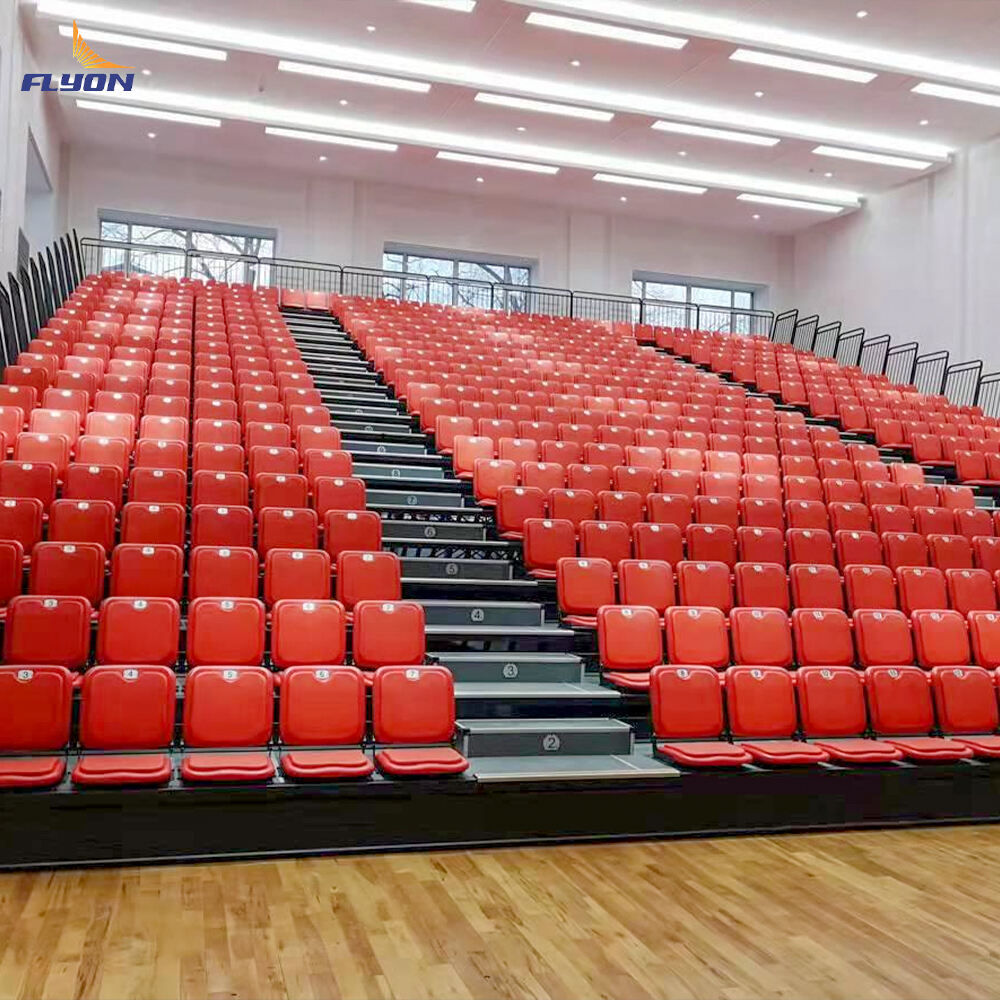Vai Trò Chiến Lược của Thiết Kế Ghế Rạp Chiếu Phim trong Trải Nghiệm Sống Động
Thiết Kế Mỹ Học Ghế Rạp Chiếu Phim Ảnh Hưởng Như Thế Nào Đến Mức Độ Tham Gia của Khán Giả
Việc ghế trong rạp chiếu phim trông như thế nào ảnh hưởng rất lớn đến trải nghiệm của khán giả ngay từ khoảnh khắc họ bước vào. Theo một số nghiên cứu thiết kế từ năm ngoái, những nơi có tất cả các ghế phù hợp với một chủ đề nhất định đã ghi nhận mức độ hài lòng của khách hàng cao hơn khoảng 31 phần trăm so với những địa điểm sử dụng kiểu bố trí nhàm chán, một kích cỡ cho tất cả. Những yếu tố như tay vịn cong trên ghế, đèn đổi màu đồng bộ, hay chất liệu vải có kết cấu đặc biệt thực sự giúp kể lên câu chuyện riêng của chính không gian đó. Hãy nghĩ xem: một số rạp chiếu phim đầu tư mạnh vào phong cách cụ thể, khiến người ta cảm giác như đang quay trở lại những rạp phim cổ xưa hoặc như đang bước vào một không gian hoàn toàn mới mẻ và công nghệ cao. Chúng tôi cũng nhận thấy rằng khi các ghế được sắp xếp sao cho ai cũng có thể nhìn rõ và phối màu đồng bộ xuyên suốt, khán giả dường như bị phân tâm ít hơn trong suốt buổi biểu diễn. Các nghiên cứu chỉ ra rằng mức độ phân tâm giảm khoảng 22 phần trăm nhờ những bố trí tinh tế này.
Tích hợp Ghế Tùy chỉnh cùng Phụ kiện để Đảm bảo Tính Nhất quán về Chủ đề
Khi các địa điểm thêm những chi tiết như giá để cốc dạng mô-đun, khay đựng đồ ăn nhẹ trượt được và các tấm ốp ghế có in thương hiệu tùy chỉnh, họ về cơ bản đang kể chuyện thông qua các yếu tố thiết kế vượt xa hơn so với chỉ đơn thuần là những chiếc ghế. Hãy nghĩ theo cách này: việc kết hợp ghế nhung mềm mại với những đèn tường phong cách Art Deco sang trọng sẽ tạo nên cảm giác hoài cổ và phong cách cổ điển thực sự ấn tượng. Ngược lại, những thiết kế tinh tế hơn với cổng USB tích hợp lại toát lên sự tiện nghi hiện đại. Mối liên hệ giữa lựa chọn nội thất và thiết kế tổng thể không gian cũng tạo nên sự khác biệt rõ rệt. Những nơi mà tất cả các chi tiết này được phối hợp ăn ý thường thu hút lượng tương tác trên mạng xã hội tăng khoảng 19 phần trăm từ khách tham quan, theo các nghiên cứu gần đây.
Nghiên cứu trường hợp: Cải tạo rạp chiếu phim theo chủ đề sử dụng bố trí ghế rạp tùy chỉnh
Một nhà hát cũ nằm ở Barcelona đã cải tạo toàn bộ nội thất khi thay thế tất cả những chiếc ghế cứng nhắc bằng những mẫu ghế linh hoạt và được thiết kế riêng theo chủ đề cụ thể. Những gì họ tạo ra là các hàng ghế xếp lệch nhau, trang bị đầy đủ ghế da màu đỏ đậm cùng với các bàn nhỏ tích hợp ngay vào ghế, tất cả đều được thiết kế để phù hợp với kỳ vọng của khán giả về một không gian nhà hát opera cổ điển thập niên 1920. Sau khi thực hiện những thay đổi này, tỷ lệ lấp đầy chỗ ngồi tại địa điểm này tăng gần 30 phần trăm. Khi hỏi ý kiến khách tham quan về cảm nhận sau đợt cải tạo, gần như tất cả mọi người (khoảng 94%) cho rằng cách bố trí mới này gần như là yếu tố cần thiết để tạo nên bầu không khí đặc biệt mà địa điểm này vốn nổi tiếng. Vì vậy, hóa ra các thiết kế tùy chỉnh hoàn toàn có thể không làm mất đi vẻ cổ điển, đồng thời vẫn đảm bảo tính thẩm mỹ và hiệu quả sử dụng tốt hơn.
Đổi mới vật liệu trong sản xuất ghế nhà hát: Cân bằng giữa sang trọng và bền vững
Lợi thế của chất liệu da cao cấp trong xây dựng ghế nhà hát
Da cao cấp vẫn là tiêu chuẩn vàng cho ghế ngồi rạp chiếu phim sang trọng, mang lại tuổi thọ từ 7–10 năm trong môi trường thương mại và độ thoải mái vượt trội. Khả năng thoáng khí tự nhiên của da điều hòa nhiệt độ hiệu quả hơn 30% so với vật liệu tổng hợp, theo các nghiên cứu về công thái học, đồng thời phát triển lớp bóng mờ đẹp theo thời gian, phù hợp với nội thất rạp chiếu phim cổ điển.
Bền vững vs. Độ bền: Xu hướng chuyển dịch sang đồ nội thất rạp phim tại gia thân thiện với môi trường
Bền vững đã trở thành yếu tố thực sự quan trọng trong những năm gần đây. Theo một nghiên cứu gần đây của CSM International vào năm 2023, khoảng hai phần ba các đơn vị vận hành địa điểm mong muốn sử dụng vật liệu bền vững nhưng vẫn yêu cầu độ bền lâu dài. Vậy các nhà sản xuất đang làm gì để đáp ứng điều này? Rất nhiều công ty đã bắt đầu áp dụng quy trình thuộc da không sử dụng crom và sản xuất vật liệu tổng hợp từ da tái chế. Phương pháp này thực tế giúp giảm đáng kể lượng nước tiêu thụ so với các phương pháp truyền thống trước đây – giảm trung bình khoảng 45% lượng nước. Và thú vị thay, điều này phù hợp với một báo cáo khác từ CSM International về đổi mới vật liệu. Nghiên cứu của họ cho thấy người tiêu dùng sẵn sàng chi thêm khoảng 18% nếu biết ghế hạng sang của họ được sản xuất theo cách bền vững. Điều này hoàn toàn hợp lý khi cân nhắc mức giá mà các địa điểm hiện nay thu từ khách hàng cho trải nghiệm cao cấp.
Nghịch lý ngành: Kiểu dáng cao cấp vs. Thách thức bảo trì trong ghế da
Ghế da có thể làm tăng khoảng 22% giá trị mà người dùng cảm nhận về vé của họ, theo Báo cáo Dịch vụ Khách hàng J.D. Power 2024. Tuy nhiên, các quản lý rạp chiếu phim hiện nay lại kể một câu chuyện khác. Khoảng 41% phàn nàn về khoản chi phí tốn kém để giữ ghế da sạch sẽ mỗi ngày cùng với việc phải bảo dưỡng hai lần mỗi năm. Những vấn đề này đã khiến nhiều rạp tìm kiếm các giải pháp thay thế. Một số rạp giờ đây chọn ghế có lớp phủ đặc biệt chống bám bẩn, trong khi những rạp khác kết hợp sử dụng da thật chỉ ở những vị trí quan trọng nhất — khu vực ngồi chính. Đối với các phần ít thấy hơn như tay vịn và thành ghế, họ đang chuyển sang dùng vật liệu có nguồn gốc thực vật. Điều này hoàn toàn hợp lý khi cân nhắc cả yếu tố ngân sách và kỳ vọng của khán giả hiện đại.
Tích hợp Không gian: Bố trí Ghế Rạp hát Phù hợp với Dòng Nội thất Kiểu Rạp Chiếu phim
Bố trí Ghế Rạp hát Phù hợp với Dòng Nội thất Kiểu Rạp Chiếu phim
Cách bố trí ghế trong rạp chiếu phim thực sự tạo nên sự khác biệt về trải nghiệm xem phim của khán giả. Khi các tầm nhìn được thiết kế đúng như kế hoạch ban đầu của kiến trúc sư, người xem sẽ cảm nhận được sự nhập vai tốt hơn vào nội dung phim. Phần lớn các rạp chiếu phim hiện nay sử dụng hệ thống lắp ráp mô-đun, đảm bảo khoảng cách tối thiểu 1,1 mét (khoảng 43 inch) giữa các hàng ghế để mọi người có thể ngồi thoải mái. Đồng thời, cách bố trí này giúp điều chỉnh góc nghiêng của ghế hướng đúng về phía màn hình lớn. Việc thiết kế chính xác như vậy sẽ tránh được hiện tượng gọi là 'hiệu ứng hẻm núi', khi các hàng ghế không thẳng hàng, khiến khán giả phải ngoẹo cổ hoặc bỏ lỡ một phần hình ảnh. Nghiên cứu gần đây từ năm ngoái đã tìm hiểu cách thiết kế rạp phim ảnh hưởng đến thói quen xem phim. Họ phát hiện ra một điều thú vị: những nơi có sự căn chỉnh ghế hợp lý ghi nhận số lượng người ở lại xem trọn vẹn các bộ phim dài trên hai giờ tăng khoảng 23 phần trăm so với những nơi khác.
Tối ưu Hóa Tầm Nhìn và Sự Thoải Mái Thông Qua Việc Tích Hợp Chiến Lược Trang Trí Phòng Giải Trí
Ghế ngồi kiểu rạp hát có độ rộng hẹp, thường khoảng 85 cm hoặc 33,5 inch, đã trở nên rất phổ biến trong các thiết lập rạp chiếu phim tại gia cao cấp. Những thiết kế mỏng này cho phép chủ sở hữu căn phòng bố trí thoải mái từ 12 đến 18 ghế ngay cả khi không gian bị giới hạn, ví dụ như trong một căn phòng có diện tích dưới 40 mét vuông hay khoảng 430 feet vuông. Các chuyên gia thực hiện lắp đặt cẩn thận sắp xếp các tấm cách âm và điều chỉnh độ ngả tối đa của ghế ngả để đảm bảo âm thanh được kiểm soát trong phạm vi mong muốn từ 50 đến 60 decibel. Sự chú ý tỉ mỉ này đảm bảo lời thoại phim được truyền đạt rõ ràng mà không bị lẫn vào tiếng ồn nền. Một số mẫu mới gần đây được trang bị loa định hướng tích hợp, giúp giảm khoảng 19 phần trăm tiếng vang không mong muốn, đặc biệt hữu ích trong những căn phòng có chiều cao trần dưới 4,8 mét hoặc khoảng 15,7 feet.
Phân tích xu hướng: Sự gia tăng của đồ nội thất phong cách rạp chiếu phim tối giản tại các địa điểm đô thị
Các ghế ngồi nhỏ gọn có động cơ với chiều dài dưới 43 inch hiện đang tạo nên làn sóng tại các trung tâm thành phố, chiếm gần hai phần ba tổng doanh số nhờ sự gia tăng của các không gian sử dụng đa chức năng. Thiết kế thông minh cho phép các địa điểm xếp ghế thành bốn tầng ngay cả khi trần nhà chỉ khoảng 10 feet mà không làm mất khoảng cách quan trọng giữa màn hình và hàng ghế đầu tiên. Chúng ta đang chứng kiến xu hướng chuyển sang định dạng nhỏ hơn thúc đẩy sự phát triển của các rạp chiếu phim mini với 50 chỗ ngồi hoặc ít hơn. Những rạp phim nhỏ này đã tăng trưởng gần 40 phần trăm kể từ đầu năm 2022, và nhiều chủ sở hữu nhận thấy bố trí ghế linh hoạt của họ hoạt động hiệu quả không kém gì cho các buổi biểu diễn âm nhạc trực tiếp hay triển lãm nghệ thuật so với chiếu phim.
Các Lộ Trình Tùy Chỉnh Toàn Bộ cho Cấu Hình Ghế Xem Phim
Các Tùy Chọn Tùy Chỉnh từ Các Nhà Sản Xuất Hàng Đầu cho Chủ Đề Địa Điểm Độc Đáo
Ngày nay, các nhà sản xuất thực sự rất chú trọng đến việc tùy chỉnh ghế ngồi sao cho phù hợp với các phong cách kiến trúc khác nhau hoặc nhận diện thương hiệu của công ty. Các lựa chọn hiện có thực sự ấn tượng - có hơn hai trăm loại vải để lựa chọn, cùng các tính năng như tựa lưng điều chỉnh được để tăng sự thoải mái, và thiết kế chân đế có thể điều chỉnh để phù hợp với gần như mọi chủ đề tưởng tượng được. Hãy nghĩ đến phong cách Art Deco đầy cá tính vào ngày này, rồi đến một thứ gì đó cực kỳ thanh lịch và hiện đại vào ngày khác. Một ví dụ thực tế xảy ra tại một rạp chiếu phim kiểu Gothic cổ điển, nơi họ đã lắp đặt những chiếc ghế đặc biệt với các họa tiết dập nổi phù hợp với trần nhà cao của mình. Sau khi nâng cấp đơn giản này, theo báo cáo, thời gian khách hàng lưu lại khu vực rạp phim đã tăng thêm khoảng 19 phần trăm. Một kết quả khá ấn tượng cho một lựa chọn thiết kế cụ thể như vậy!
Phụ kiện mô-đun: Giá để ly, Bàn rút gọn, và Đèn tích hợp
Ghế rạp chiếu phim hiện đại hỗ trợ các phụ kiện cắm vào và sử dụng ngay, có thể thích nghi với nhiều chức năng khác nhau:
- Khay đựng đồ ăn nhẹ dạng rút gọn gấp gọn khi chiếu phim nhưng mở ra khi tổ chức sự kiện
- Đèn LED RGB gắn dưới đáy đồng bộ với hoạt ảnh trước buổi biểu diễn thông qua bộ điều khiển DMX
- Giá để cốc tháo nhanh với các góc chống tràn giúp giảm chi phí làm sạch 27% (Báo cáo Các Nhà Vận hành Sân khấu Quốc gia 2023)
Các tính năng này cho phép các địa điểm chuyển đổi giữa chế độ rạp chiếu phim, esports và hội thảo trong vòng chưa đến 90 phút.
Các Lộ trình Cá nhân hóa: Từ Phối màu đến Logo Khắc nổi trên Ghế Rạp
Các công cụ cá nhân hóa thẩm mỹ hiện bao gồm nhuộm da đạt chứng nhận Pantone để phối chính xác màu sắc thương hiệu, khắc laser logo tựa đầu có thể nhìn thấy dưới ánh sáng UV, và các tấm bọc đệm thay thế được để cập nhật theo mùa. Một chuỗi rạp khu vực báo cáo doanh số bán đồ ăn nhẹ tăng 12% sau khi tích hợp các minh họa thực đơn tinh tế vào vải ghế.
Phân tích Tranh luận: Chuẩn hóa hay Tùy chỉnh Toàn bộ trong Các Lắp đặt Thương mại
Hiện đang có một sự chia rẽ rõ rệt trong ngành công nghiệp này. Một mặt, các chuỗi rạp chiếu phim lớn đang tập trung hoàn toàn vào ghế ngồi theo tiêu chuẩn ISO vì điều này giúp tiết kiệm chi phí và dễ dàng bảo trì hơn. Trong khi đó, các rạp chiếu phim nhỏ, chuyên biệt lại đi theo hướng hoàn toàn ngược lại, lựa chọn những thiết lập tùy chỉnh hoàn toàn nhằm tạo ra những trải nghiệm đáng nhớ cho khán giả. Các con số cũng chứng minh điều này. Theo Tạp chí Xu hướng Giải trí năm ngoái, việc sử dụng ghế ngồi tiêu chuẩn giúp giảm khoảng 35% chi phí mỗi chiếc ghế. Nhưng khi các rạp chiếu phim sử dụng ghế tùy chỉnh, mức độ lan truyền trên mạng xã hội của họ tăng gần 41%. Tuy nhiên, một số người thông minh đã bắt đầu kết hợp cả hai cách tiếp cận này. Chúng ta đang thấy những cấu trúc khung tiêu chuẩn được ghép nối với các tùy chọn bọc đệm có thể thay thế, cho phép các địa điểm thay đổi kiểu dáng theo mùa mà không phải tốn kém mua sắm nội thất mới hoàn toàn mỗi lần.
Câu hỏi thường gặp
Câu hỏi: Tại sao thiết kế ghế rạp chiếu phim lại quan trọng trong các trải nghiệm sống động?
A: Thiết kế ghế rạp hát ảnh hưởng đến cách khán giả tương tác bằng cách tăng tính thẩm mỹ và phù hợp với môi trường chủ đề, từ đó có thể nâng cao sự hài lòng của khách hàng lên 31%.
Q: Ghế rạp tùy chỉnh được tích hợp vào thiết kế tổng thể của rạp như thế nào?
A: Các ghế tùy chỉnh có thể bao gồm các tính năng như giá để cốc dạng mô-đun và các tấm ốp thương hiệu, góp phần vào việc kể chuyện và duy trì sự nhất quán về chủ đề.
Q: Lợi ích của việc sử dụng da cao cấp trong ghế rạp là gì?
A: Da cao cấp mang lại độ bền, sự thoải mái và khả năng điều hòa nhiệt độ tốt hơn so với các vật liệu tổng hợp, từ đó nâng cao giá trị sang trọng và thẩm mỹ.
Q: Có sử dụng vật liệu bền vững trong sản xuất ghế rạp không?
A: Có, các công nghệ bền vững như thuộc da không chứa crôm và hỗn hợp da tái chế đang được sử dụng, giúp giảm tiêu thụ nước tới 45%.
Mục Lục
- Vai Trò Chiến Lược của Thiết Kế Ghế Rạp Chiếu Phim trong Trải Nghiệm Sống Động
- Đổi mới vật liệu trong sản xuất ghế nhà hát: Cân bằng giữa sang trọng và bền vững
- Tích hợp Không gian: Bố trí Ghế Rạp hát Phù hợp với Dòng Nội thất Kiểu Rạp Chiếu phim
- Các Lộ Trình Tùy Chỉnh Toàn Bộ cho Cấu Hình Ghế Xem Phim
- Câu hỏi thường gặp
 EN
EN
 AR
AR
 FR
FR
 PT
PT
 RU
RU
 ES
ES
 BG
BG
 HR
HR
 CS
CS
 DA
DA
 NL
NL
 FI
FI
 DE
DE
 EL
EL
 HI
HI
 IT
IT
 JA
JA
 KO
KO
 NO
NO
 PL
PL
 RO
RO
 SV
SV
 CA
CA
 TL
TL
 ID
ID
 SR
SR
 SK
SK
 UK
UK
 VI
VI
 HU
HU
 TH
TH
 TR
TR
 MS
MS
 AZ
AZ
 KA
KA
 BN
BN
 LO
LO
 MN
MN
 MY
MY
 UZ
UZ


